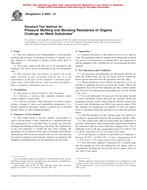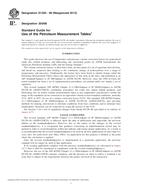1.1 These test methods cover procedures for testing an individual vertical or inclined deep foundation to determine the displacement response to an axial compressive force pulse applied at its top. These test methods apply to all deep foundation units, referred to herein as “piles,“ that function in a manner similar to driven or cast-in-place piles, regardless of their method of installation.
1.2 Two alternative procedures are provided:
1.2.1 Procedure A uses a combustion gas pressure apparatus to produce the required axial compressive force pulse.
1.2.2 Procedure B uses a cushioned drop mass apparatus to produce the required axial compressive force pulse.
1.3 This standard provides minimum requirements for testing deep foundations under an axial compressive force pulse. Plans, specifications, provisions (or combinations thereof) prepared by a qualified engineer, may provide additional requirements and procedures as needed to satisfy the objectives of a particular deep foundation test program. The engineer in responsible charge of the foundation design, referred to herein as the “Engineer“, shall approve any deviations, deletions, or additions to the requirements of this standard.
1.4 The proper conduct and evaluation of force pulse testing requires special knowledge and experience. A qualified engineer should directly supervise the acquisition of field data and the interpretation of the test results so as to predict the actual performance and adequacy of deep foundations used in the constructed foundation. A qualified engineer shall approve the apparatus used for applying the force pulse, rigging and hoisting equipment, support frames, templates, and test procedures.
1.5 The text of this standard references notes and footnotes which provide explanatory material. These notes and footnotes (excluding those in tables and figures) shall not be considered as requirements of the standard. The word “shall“ indicates a mandatory provision, and the word “should“ indicates a recommended or advisory provision. Imperative sentences indicate mandatory provisions.
1.6 The values stated in SI units are to be regarded as standard. No other units of measurement are included in this standard.
1.7 All observed and calculated values shall conform to the guidelines for significant digits and rounding established in Practice D 6026.
1.8 The method used to specify how data are collected, calculated or recorded in this standard is not directly related to the accuracy to which the data can be applied in the design or other uses, or both. How one uses the results obtained using this standard is beyond its scope.
1.9 ASTM International takes no position respecting the validity of any patent rights asserted in connection with any item mentioned in this standard. Users of this standard are expressly advised that determination of the validity of any such patent rights, and the risk of infringement of such rights, are entirely their own responsibility.
1.10 This standard may involve hazardous materials, operations, and equipment. This standard does not purport to address all of the safety concerns, if any, associated with its use. It is the responsibility of the user of this standard to establish appropriate safety and health practices and determine the applicability of regulatory limitations prior to use. Section 7 provides a partial list of specific hazards and precautions.
Product Details
- Published:
- 10/01/2008
- Number of Pages:
- 9
- File Size:
- 1 file , 160 KB


